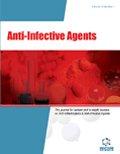Abstract
The development of antimicrobial agents to treat infections has been one of the most notable medical achievements of the past century. Despite the growing list of azoles, their clinical value has been limited by their relatively high risk of toxicity and the emergence of drug resistance. This necessitates the development of more effective broad spectrum antimicrobials with fewer side effects. We previously described the design and synthesis of some new azole derivatives in both imidazole and triazole groups. Here we selected 30 analogues of them in 4 different categories (imidazoles (1), benzimidazoles (2), triazoles (3) and benztriazoles (4)) and investigated their antibacterial activity against different species of gram positive and gram negative microorganisms. Staphylococcus aureus, Staphylococcus epidermidis, Staphylococcus haemolyticus, Bacillus subtilis as gram positive and Escherichia coli, Salmonella typhi, Shigella sonnei, Pseudomonas aeroginosa and Proteus vulgaris as gram negative bacteria were chosen. Disc plate method and serial dilution assay were used to establish the minimum inhibitory concentration of the above compounds. The results show compounds 1-dodecyl- 2-methyl-1H-imidazole (1g), 2-(1H-1-imidazolyl)-1-cyclohexanol (1a) and 2-(2-methyl-4-nitro-1H-1-imidazolyl)-1- cyclohexanol (1o) had desirable antibacterial activity on both gram positive and gram negative species. Compounds 1- trityl-1H-benzo (d) imidazole (2a) and 1-octyl-1H-1,2,4-triazole (3b) had higher effect for gram positive and gram negative bacteria respectively. Compounds 2-methyl-1- nonyl-1H-imidazole (1f) and 1-butyl-2-methyl-;4-nitro-1H-imidazole (1l) had moderate activity for gram negative bacteria.
Keywords: Imidazole, triazole, benzimidazole, benztriazole, antibacterial, Medicinal Chemistry, 1-dodecyl-2-methyl-1H-imidazole, azole ring
Anti-Infective Agents
Title: Antibacterial Activity of Some New Azole Compounds
Volume: 10 Issue: 1
Author(s): S. Khabnadideh, Z. Rezaei, Y. Ghasemi and N. Montazeri-Najafabady
Affiliation:
Keywords: Imidazole, triazole, benzimidazole, benztriazole, antibacterial, Medicinal Chemistry, 1-dodecyl-2-methyl-1H-imidazole, azole ring
Abstract: The development of antimicrobial agents to treat infections has been one of the most notable medical achievements of the past century. Despite the growing list of azoles, their clinical value has been limited by their relatively high risk of toxicity and the emergence of drug resistance. This necessitates the development of more effective broad spectrum antimicrobials with fewer side effects. We previously described the design and synthesis of some new azole derivatives in both imidazole and triazole groups. Here we selected 30 analogues of them in 4 different categories (imidazoles (1), benzimidazoles (2), triazoles (3) and benztriazoles (4)) and investigated their antibacterial activity against different species of gram positive and gram negative microorganisms. Staphylococcus aureus, Staphylococcus epidermidis, Staphylococcus haemolyticus, Bacillus subtilis as gram positive and Escherichia coli, Salmonella typhi, Shigella sonnei, Pseudomonas aeroginosa and Proteus vulgaris as gram negative bacteria were chosen. Disc plate method and serial dilution assay were used to establish the minimum inhibitory concentration of the above compounds. The results show compounds 1-dodecyl- 2-methyl-1H-imidazole (1g), 2-(1H-1-imidazolyl)-1-cyclohexanol (1a) and 2-(2-methyl-4-nitro-1H-1-imidazolyl)-1- cyclohexanol (1o) had desirable antibacterial activity on both gram positive and gram negative species. Compounds 1- trityl-1H-benzo (d) imidazole (2a) and 1-octyl-1H-1,2,4-triazole (3b) had higher effect for gram positive and gram negative bacteria respectively. Compounds 2-methyl-1- nonyl-1H-imidazole (1f) and 1-butyl-2-methyl-;4-nitro-1H-imidazole (1l) had moderate activity for gram negative bacteria.
Export Options
About this article
Cite this article as:
Khabnadideh S., Rezaei Z., Ghasemi Y. and Montazeri-Najafabady N., Antibacterial Activity of Some New Azole Compounds, Anti-Infective Agents 2012; 10 (1) . https://dx.doi.org/10.2174/2211362611201010026
| DOI https://dx.doi.org/10.2174/2211362611201010026 |
Print ISSN 2211-3525 |
| Publisher Name Bentham Science Publisher |
Online ISSN 2211-3533 |
 27
27
- Author Guidelines
- Bentham Author Support Services (BASS)
- Graphical Abstracts
- Fabricating and Stating False Information
- Research Misconduct
- Post Publication Discussions and Corrections
- Publishing Ethics and Rectitude
- Increase Visibility of Your Article
- Archiving Policies
- Peer Review Workflow
- Order Your Article Before Print
- Promote Your Article
- Manuscript Transfer Facility
- Editorial Policies
- Allegations from Whistleblowers
- Announcements


























